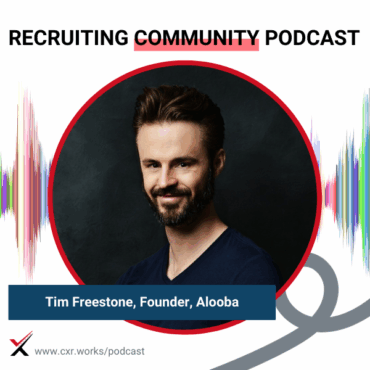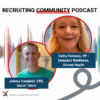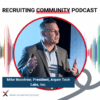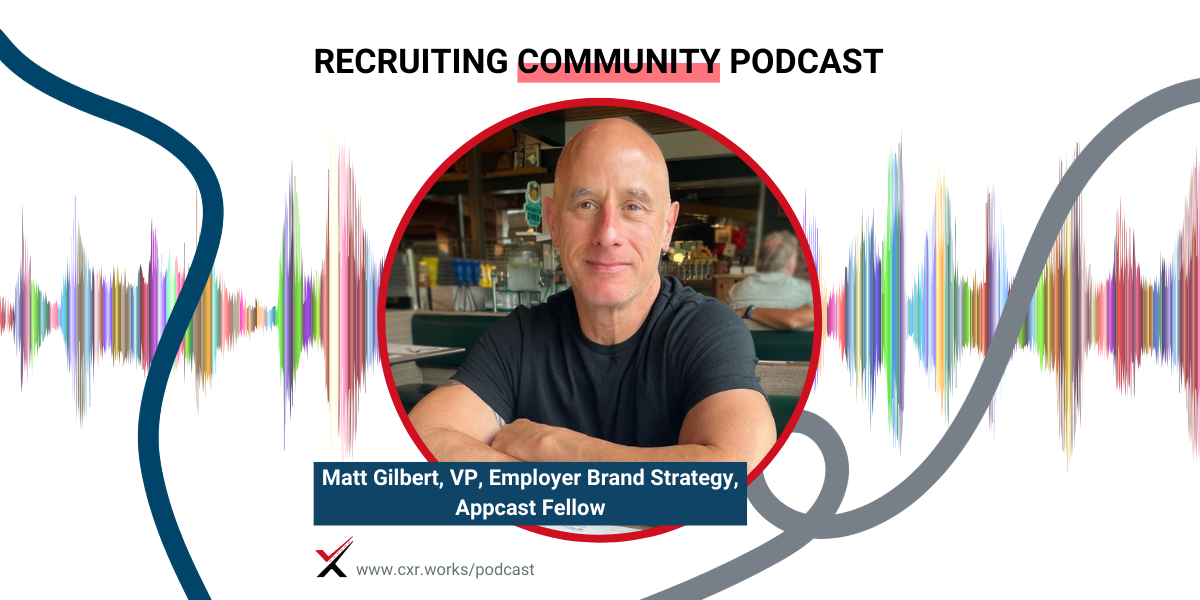
Hiring Without Bias: The Alooba Approach to Smarter Recruitment
What happens when skills take center stage in hiring? Alooba’s Tim Freestone joins CXR to talk candidate assessments, objectivity, and the road to trust.
 play_arrow
play_arrow
AI in Talent Acquisition Cami Grace
 play_arrow
play_arrow
Balancing Strategy and Tactics: Melissa Thompson’s Career Crossroads Cami Grace
 play_arrow
play_arrow
Real-Time Jobs Data and the TA Advantage Cami Grace
 play_arrow
play_arrow
20+ Years at Dell and Beyond: Jennifer Newbill’s Career Crossroads Cami Grace

Featured Guests:
Matt Gilbert, Vice President of Employer Brand Strategy, Appcast
Hosts:
Chris Hoyt, President, CareerXroads
Gerry Crispin, Co-founder, CareerXroads
Episode Overview:
Chris Hoyt and Gerry Crispin speak with Matt Gilbert of Appcast about the evolving dynamics of employer branding—who defines it, who controls it, and how its value is measured. With experience leading over 350 EB programs, Matt offers clear insights into the power struggles, metrics, and alignment challenges that shape employer brand strategy today.
Key Topics:
The role of candidates, employees, and leadership in shaping employer brand
Why alignment between internal experience and brand messaging matters
Shifts in reporting structures—TA vs. Marketing vs. Communications
The importance of transparency and authentic storytelling
How metrics like collaboration, retention, and perception signal brand strength
Challenges in measuring emotional impact and ROI
Employer brand maturity and the rise of internal EB professionals
Career-path-based branding and its long-term value
Mobility as a driver of retention and innovation
Notable Quotes:
“The answer no one likes is: Everyone owns employer brand—but not equally.” — Matt Gilbert
“Just because something’s hard to measure doesn’t mean it’s not important.” — Matt Gilbert
“Imagine telling candidates: ‘Here’s what we’re working on improving.’ That’s honest.” — Matt Gilbert
“EB that aligns with real career paths is more effective and longer-lasting.” — Matt Gilbert
Takeaways:
Employer brand is a shared responsibility—but alignment is key to its success. Matt Gilbert highlights the need for consistent messaging, cross-functional collaboration, and transparent communication to create an EB strategy that delivers real value. Measurable or not, the perception of a workplace directly influences outcomes from hiring to retention.
Want more conversations like this?
Subscribe to the CXR podcast and explore how top talent leaders are shaping the future of recruiting. Learn more about the CareerXroads community at cxr.works.
Announcer: Welcome to the Recruiting Community Podcast, the go-to channel for talent acquisition leaders and practitioners. This show is brought to you by CXR, a trusted community of thousands connecting the best minds in the industry to explore topics like attracting, engaging, and retaining top talent. Hosted by Chris Hoyt and Jerry Crispin.
We are thrilled to have you join the conversation.
Chris Hoyt: I’m Chris Hoyt, president of CXR. I’ve got Jerry Crispin, co-founder of CareerXroads, with me. We’re your hosts, and the idea here is to bring you industry insights and updates in the form of fun conversation, brought to you by the CXR community.
Today, I’m excited to have Appcast’s Matt Gilbert with us. We’re going to talk about who really decides the value of employer brand—whether it’s candidates, employees, the C-suite—and we’ll unpack who holds the power in shaping EB strategy, and how that perception drives measurable impact for the business.
A couple things before we jump in: we’re streaming on all the socials—YouTube, Facebook, LinkedIn, even Twitch. If you’re watching live, you can drop comments or questions, especially if you’ve got something for Matt, Jerry, or myself. We’ll chime in if we can. You can check out cxr.works/podcast for past and future episodes.
And as a quick reminder—this is an ad-free labor of love. We’re creeping up on episode 500, and no one pays to be here. We bring on people doing cool work with strong opinions, and we want to hear them.
Did I miss anything, Jerry?
Jerry Crispin: Nope, you got it all. Thanks.
Matt Gilbert: Like an old married couple. I love it.
Chris Hoyt: So Matt, I mentioned you’re from Appcast, but you want to give us a little history? Who is Matt Gilbert, and why should we be listening to you?
Matt Gilbert: Happy to. Chris, Jerry, thank you so much for having me.
I’m Matt Gilbert, Vice President of Employer Brand Strategy at Appcast. About a year and a half ago, Appcast acquired Bayard—where I had worked since 2004. We’d been partners for over a decade, going back to the early days of programmatic. Eventually, it made sense to put the two organizations together and expand each other’s capabilities.
Funny story—before Bayard, I was working in corporate brand design and consulting. A friend called to say the creative director at Bayard had quit and asked if I was interested. I hung up on him. He called back and said, “Remember all that stuff you talked about—entrepreneurship for creatives, that grad school work?” He finally convinced me to interview.
Almost didn’t get the job because I’m a low talker. The president thought that might be a problem with clients. But we worked through it, and I ended up staying over 20 years. What I love most is applying creative marketing and branding to help people find jobs. That’s incredibly rewarding and has kept me inspired ever since.
Chris Hoyt: Let’s jump into the topic: Who really controls the perception of employer brand today? Leadership? Employees? Candidates? Or is that constantly shifting?
Matt Gilbert: Great question—and a super topical one. This has been debated since Simon Barrow coined “employer branding” in the 1990s. Control is the key word: Who steers it, develops it, executes it, measures it?
The answer no one likes is: Everyone. But not equally—and not in the same ways. That creates internal friction. I’ve worked on over 350 employer brand programs since 2004, so I’ve seen a wide range of industries and stakeholders.
What helps the most is focusing less on who owns it and more on what we want employer brand to do for our organizations. The word we always come back to is value.
What’s the value of employer brand to candidates? To employees? To the C-suite? Candidates look for authenticity and alignment. Employees are living the brand. The C-suite funds the work and ties it to strategic objectives. If those three aren’t aligned, things fall apart—people start stepping on each other’s toes or arguing about ownership.
Chris Hoyt: In the last few months, we’ve heard more leaders rethink where EB or recruitment marketing should report—should it stay in TA, move to marketing or comms? I think that speaks to a power dynamic. Is there a “right” answer?
Matt Gilbert: That’s tricky. We avoid saying “right” or “wrong” and talk instead about what’s effective. But yes, there’s a version of employer brand that lives in the C-suite, and there’s a version that lives on the ground with employees—and sometimes they’re very disconnected.
Think of it like a parade. The flag at the front is the C-suite’s version of the employer brand. But if you walk up to people in the middle of the parade and ask what the brand means to them, they’ll give you a different version. Neither one is wrong—they’re just useful in different ways.
Jerry Crispin: I think the maturity of internal EB teams has increased dramatically in recent years. Employer brand used to be an external thing—now there are skilled professionals inside companies trying to influence from within.
Matt Gilbert: Absolutely. And the closer those internal versions are connected to the C-suite version, the stronger the brand. When they’re far apart, things break down.
Chris Hoyt: That brings us to metrics. Are there specific signals or KPIs that you think prove the value of employer brand better than others?
Matt Gilbert: There are—but they’re difficult. Just because something’s hard to measure doesn’t mean it’s not important.
The holy grail is proving ROI: Does employer brand improve innovation, inclusion, retention, collaboration, speed to market? The answer is yes—but it’s hard to draw a straight line.
The analogy I like is sports. A losing team struggles to attract talent, fill stadiums, or sell merchandise. A winning team? Everyone wants to join. Same with companies—employer brand is the emotional signal that says, “This is a great place to be.”
Measuring that emotion is tough, but we can ask qualitative questions. What signals make someone believe a company is a high-quality employer? If we ask that consistently across time, we can track perception trends.
Jerry Crispin: And ideally, we tie that emotion to business performance—productivity, innovation, quality—though it’s hard with so many variables in play.
Matt Gilbert: Exactly. If you can measure increased collaboration, innovation, or reduced time-to-hire following EB work, that’s powerful. But again, emotion is tricky. Sociologists are better than marketers at measuring feelings—folks like Adam Grant or Malcolm Gladwell understand how people make decisions.
Chris Hoyt: That’s a good point. And I’d say organizations sometimes push a brand that doesn’t match reality. What do you do when the internal or candidate perception doesn’t match the actual experience?
Matt Gilbert: Great question. Every organization deals with this. It’s just part of the nature of expectations and emotions.
People join a company with assumptions—maybe based on videos, social posts, or content. But then they land in a team where the experience doesn’t match. Maybe they stick it out for a while. Maybe they try to make it work.
Authenticity isn’t just saying what sounds nice. Two people in the same job can have completely different experiences—both are authentic. So we have to balance the messaging: “This is the reality today. Here’s what it might look like tomorrow. Want to join us on that journey?”
Jerry Crispin: And the level of transparency has increased. Years ago, we didn’t even share pay openly. Now that’s expected. That transparency forces upskilling—for hiring managers, recruiters, and even candidates.
Chris Hoyt: But real transparency takes time—especially at scale. You can’t just talk to 100 employees and assume you’ve captured the whole story. It takes a deep, thoughtful process.
Matt Gilbert: Totally. Imagine if we told candidates: “Here’s the type of person who thrives here. Here’s what our challenges are. Here’s what we’re working on improving.” That’s honest. Even better—imagine if candidates could shadow for two weeks to try it out. That would solve a lot of misalignment, but we haven’t cracked that yet.
Chris Hoyt: Final question—what are companies getting right when it comes to building employer brand? What approaches stand out to you?
Matt Gilbert: I’m seeing more holistic thinking. More collaboration between TA and marketing. More attention to career path messaging—not just slogans or pillars.
Candidates think in terms of career paths—nursing, engineering, retail, whatever. EB that aligns with those paths is more effective.
And when we look at EB through that lens—what’s meaningful to someone in that career—it becomes actionable. If we can add just 1% more value at multiple points, that compounds into a better candidate, a better hire, a better employee.
Chris Hoyt: And EB built on that foundation has longer legs. It lasts. And if you double down on things like mobility, you’re creating real track for people’s growth.
Matt Gilbert: Absolutely. If we can improve mobility even 5%, it impacts retention, engagement, innovation, everything. Knowledge moves with people, and everyone benefits.
Chris Hoyt: Alright Matt, we wrap every show with this: If you were going to write a book on this topic, what would you title it?
Matt Gilbert: The Art and Science of Storytelling. Everything we do—marketing, TA, product—is storytelling. So the book would start: “Once upon a time, there was an organization…”
Chris Hoyt: I love it. And who gets the first signed copy—present company excluded?
Matt Gilbert: That would be my wife. She’s put up with me obsessing over how people make career decisions for 20 years. She deserves it.
Chris Hoyt: Post-pandemic, that’s the right answer. Anyone who survived lockdown with you gets the credit.
Matt Gilbert: You’re exactly right.
Chris Hoyt: Matt, thanks so much for joining us. We know you’re busy and really appreciate the time.
Matt Gilbert: My pleasure. Thank you both so much for having me.
Chris Hoyt: Always great to see you. For everyone listening, check out cxr.works/podcast for upcoming shows—and hit all the buttons: subscribe, like, follow, whatever you see. We’ll see you in a week.
Announcer: Thanks for listening to the Recruiting Community Podcast, where talent acquisition leaders connect, learn, and grow together. Be sure to visit cxr.works/podcast to explore past episodes, see what’s coming up next, and find out how you can join the conversation.
Whether you’ve got insights to share or want to be a guest on the show, we’d love to hear from you. If you’re interested in learning more about becoming a member of the CXR community, visit us at www.cxr.works. We’ll catch you in the next episode.
Tagged as: Value, Brand, Employer Brand, Appcast, Bayard, career path branding, employee engagement, employer branding ownership, Talent Acquisition, EB strategy, Human Resources, EB metrics, Company Culture, Internal Mobility, Branding.

What happens when skills take center stage in hiring? Alooba’s Tim Freestone joins CXR to talk candidate assessments, objectivity, and the road to trust.